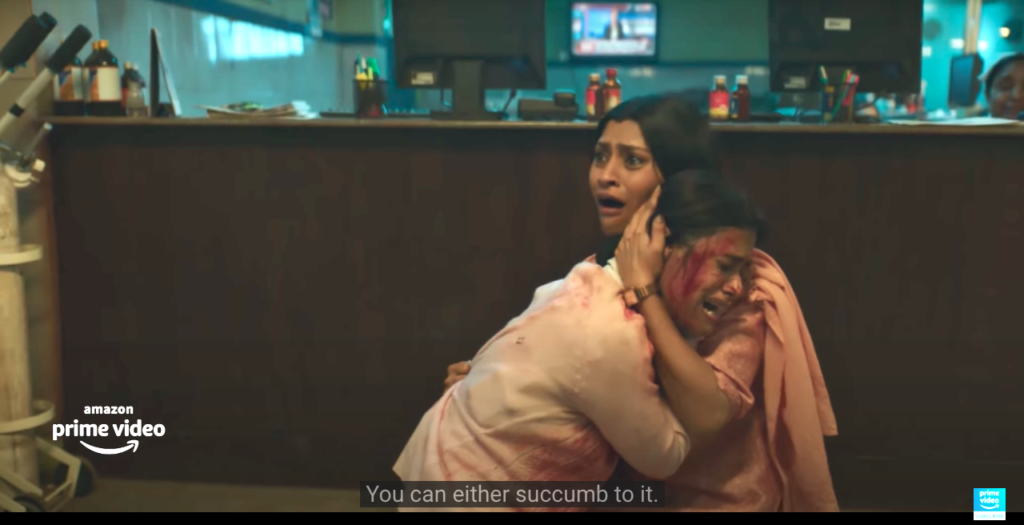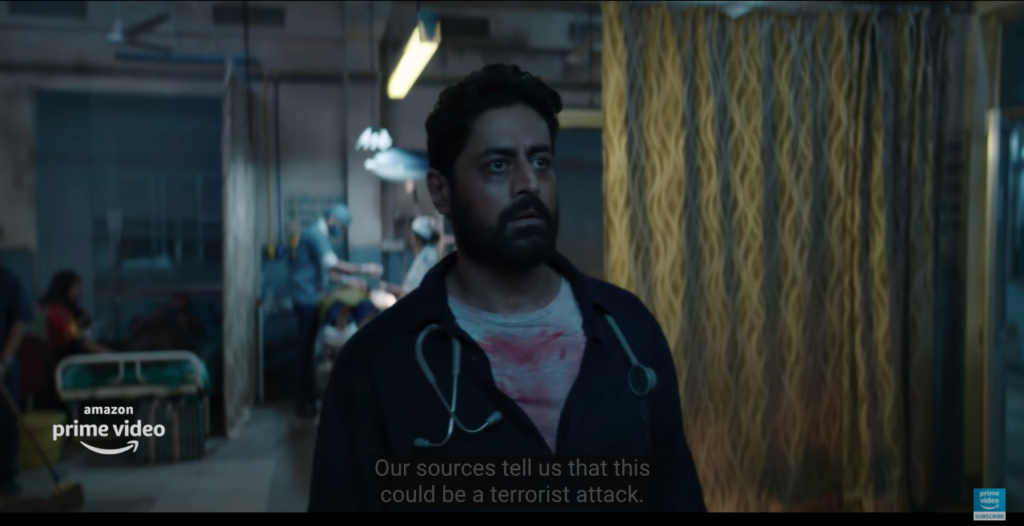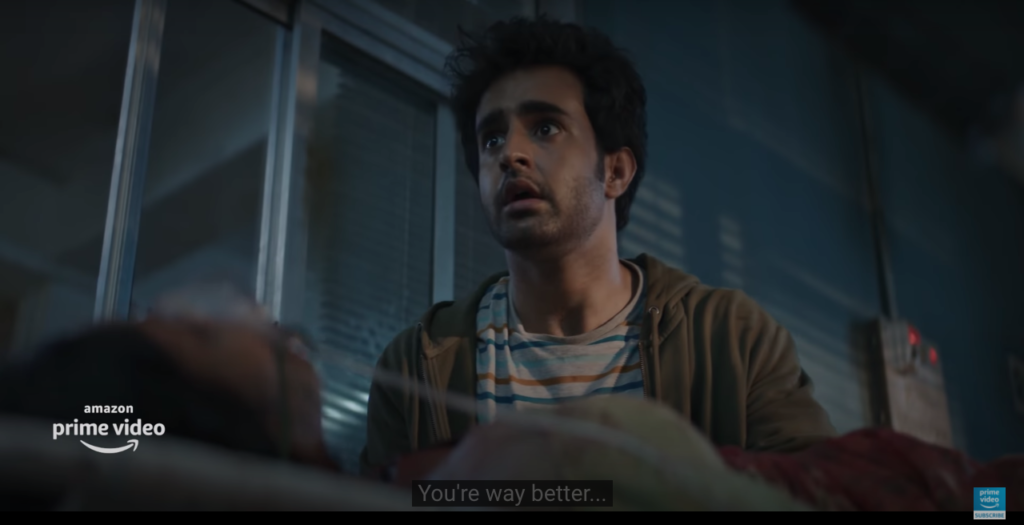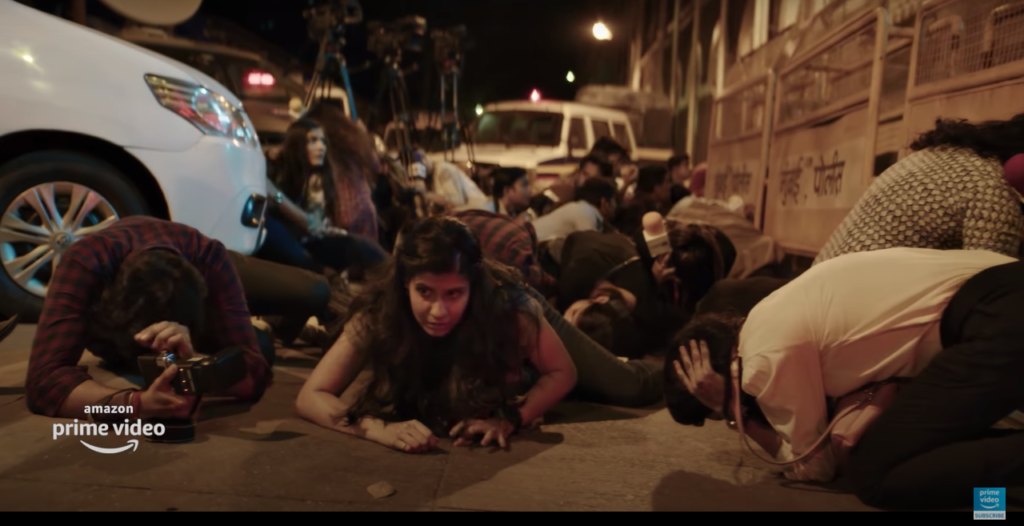March 21, 2020. I was on my way back home from an urgent closure meeting as I gazed down a completely vacant Queen’s Necklace, The Marine Drive. An unprecedented sight, an uncomfortable view, thereby inexplicable. For you don’t want to reminisce what’s jarring to the soul. It was not holiday calm but the lull before an impending doom. Something similar the city had confronted 12 years ago. The 26/11 Attacks. A situation so dreadful and uncomfortable, most don’t opt to even have a fleeting thought of it.
Reasons why, fictional revisits and documentary reruns on the same haven’t found the roaring success other topics could’ve garnered. RGV’s film, the Dev Patel starrer and most other works of art have fizzled out of public memory for the stains still bring back horrors of the time gone by. Thus, taking a nosedive into the retelling isn’t just a task daunting but also haunting enough.
Enter Mumbai Diaries 26/11.

Still from Mumbai Diaries 26/11A retrospective take on the attacks from the medical prism. Set in a dramatized iteration of Cama Hospital, where perils are aplenty but resources are meagre. The story kicks into first gear with trainees Ahaan, Diya and Sujata essayed with lifelike nativity and nuance by Satyajeet Dubey, Natasha Bhardwaj and Mrunmayee Deshpande who are planted into the sea of chaotic harmony orchestrated by Dr. Kaushik Oberoi and team, for whom the emergency room is a war-zone of resource deficit risks. The premise of the hospital is set in long takes and the parallel leads holding the narrative uptight, seamlessly.
Balaji Gauri, Pushkaraj Chirputkar and Aditi Kalkunte deserve special mention for extracting meat out of characters that could’ve otherwise stayed vanilla. There’s tension lurking around always at Bombay General Hospital; that’s what they’ve named it. As the smoke is a trail of the approaching flare and eventual gush of flames.
While watching the Marvel What If…? series I realised how Dr. Strange’s Cloak of Levitation is a silent character with its nuances conjugating key dots of the narrative. It’s the final member of the cast. The silent character. In Mumbai Diaries 26/11, the silent character is Bombay General Hospital. Its fungi clad walls and plaster cracking interiors speak their own language of long yearned attention. A place that hasn’t been looked well after and been allowed to crumble down with the pressure of overload. The overload of footfall, cries and fading expectations.
With outtakes exceptionally long yet suave, the environment latches onto you like an elderly soul seeking respite. You feel for the trembling building that carries thousand lives, hopes and prayers of remission and recovery every sunrise. The setting draws you in to an extent that you’re almost oblivious to the fact that it’s a show on the attacks of 26/11. Something that you’re sceptical to confront for all these years.
And that’s where the triumph of this show resides. The necessary deflection and the consequent novelty. It doesn’t reprise the attacks. It reprises the loss. It gravitates around the void of trauma and unavailable escapism.

Still from Mumbai Diaries 26/11The show renders structure to the emotional claustrophobia we all confront in life. We don’t like talking about the pandemic for it reminds us of the people we had. We don’t discuss much about the 26/11 attacks for it warps us back to the confines we felt we’d never escape.
The story of Mumbai Diaries focuses on human response to loss. A young boy Ahaan, who seeks medical credence to sway his family away from the shackles of superstition. A simpleton Diya living in an entitled brat setup who wants to escape the sexist environment she’s been brought up in, an oppressed Sujata who wants her credibility to supplant her caste in people’s notice and the trail of heroic proficiency of a head surgeon Dr. Oberoi who wants to get the job done at any cost and go back home a professional content with his day at work.
The narrative reflects everyday situations with predicaments quite alike to what we all undergo, keeping our own inhibitions and prejudices aside. The sweet spot of the story is the concise role of Chitra Das essayed by Konkona Sen Sharma, a woman who deals with patriarchal themes all around her and warrants to be known for her accountability and a mindset humane. The story is about modern day India dealing with rigid, dated problems. The attacks aren’t primal in nature but definitely the overarching thought of the show.
The action set pieces. Incredible. No machismo, no bravado and no chest thumping dialoguebaazi. The action of this show reflects the vulnerability and sense of fear a policeman strings before firing a bullet. The absence of morals and resultant fear in the eyes of the terrorists. It’s a disaster saga that draws your attention towards the frail and travails of being at war but never glorifies it’s necessity for a moment. The rage is grounded and there’s no entailing brouhaha or martyr like sacrifices to create synthetic drama or instigate a false moment.
If you’ve played first and third person shooter games like Splinter Cell and Max Payne, the immersive experience is quite alike when you watch this show. All credits to Vijay Ghodke, Priya Suhas for the art. Nitish Rambhadran for the music, Kaushal Shah for the cinematography and Maahir Javeri the editor for stitching together an audio-visual experience that’s the closest to an alternate reality game.
Mumbai Diaries is a stellar show that could’ve been iconic had there been fewer chokepoints. While the show is packaged as an ensemble, the narrative however drifts towards being a Mohit Raina- Shreya Dhanwantary show. The conniving news reporter on a prowl to pluck out newsflash material off a disaster crusade seems like a bit of stretch and also overdone in the showbiz. Clearly there was an attempt to create a quasi-antagonist out of her character Mansi but the results were underwhelming.
The last two episodes valve the pace down as the story intends to circle off the arcs between Dr. Oberoi, Trainee Diya and Sahil which quite fashionably leaves key characters played by Tina Desai, Prakash Belawadi and Indraneel Bhattacharya half-baked and underdeveloped. Thus deeming them to be nothing more than plot devices or exposition tools.
But what the show terribly falters in is handling its crowning performance, the most potent character Ahaan Mirza, played with utmost sincerity and effect by Satyajeet Dubey. In times like today, the character of an under confident twenty-something bloke oscillating between his mild nature and subdued rage against bigotry, vindictiveness and agenda profiling could’ve leased a new life into the tale.

Still from Mumbai Diaries 26/11Ahaan speaks volumes through his silence but is never allowed by the writers and director to blossom and expand what seems to be an arc tampered into a subplot. The character is kept at bay, mostly vanilla. However, the guy behind the role, Satyajeet Dubey should be lauded for playing the part with selflessness and letting the bigger picture flourish. Having watched his performances in films like Always Kabhi Kabhi and Prasthanam, the man definitely has the range and work rate ratio going in his favour. His moments with Pushkaraj and the hostage are show stealers; with a sincere ability to stay in character even when the lenses don’t focus on him.
Despite of all these roadblocks, the show steers through as a winner for all its parallel leads. Seasoned, professional actors with the credence to hold together any piece of content. A lot of the confetti shower should be directed towards the casting director of the show, Kavish Sinha, who gets every being in the series seem born to play their respective parts.
I didn’t talk much about the terror drama for it’s a visual gutpunch and tensile gem for you to relish. Mumbai Diaries 26/11 does the disaster saga genre a massive service and has cracked a new universe of storytelling wide open. It’s a riveting experience. Heart-warming and heart-wrenching simultaneously.
Two waves into the pandemic out there, Mumbai Diaries 26/11 clicks because it ticks the vital box of timing. The commonality between Covid-19 and the attacks is the contrived duality of events. It’s fear and realization throwing a collective jab at you.
In both cases, none of us could fathom what was transpiring in front of us. The invulnerability we were accustomed to was shattered. Our city, our country was going down in shambles. What couldn’t have happened, had happened. “Now what?” was asking the voice within.
India’s heart was wounded. But as a smart quip in the show opined, fear is a permanent phenomenon. It’s upon us to either be dictated by it or outgrow it. Somebody had to get back to work and lay out the message crystal clear – Hey, you got our attention. But not our freedom. Someone had to restore our faith and vigour of living free. And the doctors, frontline workers, police forces, special task forces and all the real time warriors went out there, not concerned about their own safety, to assure our free will sustains.

Still from Mumbai Diaries 26/11To say, Nikhil Advani’s career track finds a spiritual evolution from Kal Ho Naa Ho to kal zaroor hoga. As you see people raving about the show on the internet, it’s mostly for the craft the whole team put forth. But a fragment of it is a token of gratitude for addressing the elephant in the room and subtly expressing – Alright, shit just hit the roof. But we’ll put it behind and move forward. For we’ll never live in fear. We’ll never stop.
Final Verdict:
Tensile, tenacious and therapeutic. Mumbai Diaries 26/11 is a love letter to the spirit of a nation that outdoes itself when all chips are down. A nation that flourishes out of turmoil.